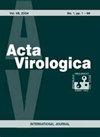Silent SARS-CoV-2 infection: seroprevalence study of SARS-CoV-2 anti- nucleocapsid IgG antibodies in Kragujevac, Serbia
IF 0.8
4区 医学
Q4 VIROLOGY
引用次数: 0
Abstract
Serological testing is a powerful tool for analyzing the infectious disease burden landscape. Therefore, this study aimed to determine the seroprevalence against SARS-CoV-2 in the population of the municipality of Kragujevac, Serbia, with a particular reference to silent infections. A total of 4,804 participants over 19 years of age were randomly sampled for population-based seroprevalence research. Anti-N IgG antibodies were measured using rapid serological tests (UNscience ® ). The population was divided into four Cohorts, according to the history of SARS-CoV-2 infection and vaccination status with the whole inactivated virus vaccine BBIBP-CorV (Vero Cell ® , Sinopharm), as follows: Cohort I—confirmed SARS-CoV-2 infection, not vaccinated with the BBIBP-CorV vaccine; Cohort II—without confirmed SARS- CoV-2 infection, vaccinated with the BBIBP-CorV vaccine; Cohort III—confirmed SARS-CoV-2 infection, vaccinated with the BBIBP-CorV vaccine; Cohort IV—without confirmed SARS-CoV-2 infection, not vaccinated with the BBIBP-CorV vaccine (silent immunization). Cohorts I and IV included patients vaccinated with vaccines other than the BBIBP-CorV vaccine. The results showed that the overall prevalence of anti-N IgG antibodies was 56.5%, with the highest seroprevalence in Cohort III at 85.8%. In Cohort IV, the prevalence of anti-N IgG antibodies was 40.7%, attributed to silent immunization. The results also suggest that the prevalence of anti-N IgG antibodies decreased over time but remained detectable for more than 12 months in Cohort I. Since currently, there is no data on silent infection frequency in our country, these findings may provide insight into the extent of silent infections in the Serbian population.无声SARS-CoV-2感染:塞尔维亚克拉古耶瓦茨地区SARS-CoV-2抗核衣壳IgG抗体血清流行率研究
血清学检测是分析传染病负担状况的有力工具。因此,本研究旨在确定塞尔维亚克拉古耶瓦茨市人口中SARS-CoV-2的血清流行率,特别是无声感染。共有4804名19岁以上的参与者被随机抽样进行基于人群的血清患病率研究。使用快速血清学测试(UNscience®)检测抗n IgG抗体。根据SARS-CoV-2感染史和接种全灭活疫苗BBIBP-CorV(中国医药集团Vero Cell®)的情况,将人群分为4个队列:队列1确诊为SARS-CoV-2感染,未接种BBIBP-CorV疫苗;队列ii -未确诊SARS- CoV-2感染,接种了BBIBP-CorV疫苗;iii队列确诊为SARS-CoV-2感染,接种了BBIBP-CorV疫苗;队列iv -未确诊SARS-CoV-2感染,未接种BBIBP-CorV疫苗(沉默免疫)。第1组和第4组包括接种了BBIBP-CorV疫苗以外疫苗的患者。结果显示,抗n IgG抗体的总体患病率为56.5%,其中队列III的血清阳性率最高,为85.8%。在队列IV中,抗n IgG抗体的患病率为40.7%,归因于沉默免疫。结果还表明,抗n IgG抗体的流行率随着时间的推移而下降,但在队列i中仍可检测到超过12个月。由于目前没有关于我国隐性感染频率的数据,这些发现可能有助于了解塞尔维亚人群中隐性感染的程度。
本文章由计算机程序翻译,如有差异,请以英文原文为准。
求助全文
约1分钟内获得全文
求助全文
来源期刊

Acta virologica
医学-病毒学
CiteScore
3.10
自引率
11.80%
发文量
43
审稿时长
>12 weeks
期刊介绍:
Acta virologica is an international journal of predominantly molecular and cellular virology. Acta virologica aims to publish papers reporting original results of fundamental and applied research mainly on human, animal and plant viruses at cellular and molecular level. As a matter of tradition, also rickettsiae are included. Areas of interest are virus structure and morphology, molecular biology of virus-cell interactions, molecular genetics of viruses, pathogenesis of viral diseases, viral immunology, vaccines, antiviral drugs and viral diagnostics.
 求助内容:
求助内容: 应助结果提醒方式:
应助结果提醒方式:


